When Were the Gospels Written?
by D.M. Murdock/Acharya S
What are the most accurate dates for the canonical gospels in the New Testament as we have them? Are these texts really the faithful accounts of eyewitnesses written shortly after Jesus's advent? Or does the evidence point to the gospels as anonymous compositions dating to the late second century?
Excerpted from
Who Was Jesus?
Fingerprints of The Christ
The Gospel Dates
"It's important to acknowledge that strictly speaking, the gospels are anonymous."
Dr. Craig L. Blomberg, The Case for Christ (26)
Because of the lack of original texts, it has been very difficult to date the canonical gospels as to when they were written or even when they first emerge in the historical record, as these two dates may differ. The gospels have been dated variously from shortly after the crucifixion, traditionally placed around 30 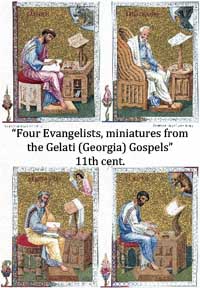 ad/ce, to as late as a century and a half afterwards.[1] The currently accepted dates are as follows, from the earliest by conservative, believing scholars to the latest by liberal and sometimes secular scholars:
ad/ce, to as late as a century and a half afterwards.[1] The currently accepted dates are as follows, from the earliest by conservative, believing scholars to the latest by liberal and sometimes secular scholars:
 ad/ce, to as late as a century and a half afterwards.[1] The currently accepted dates are as follows, from the earliest by conservative, believing scholars to the latest by liberal and sometimes secular scholars:
ad/ce, to as late as a century and a half afterwards.[1] The currently accepted dates are as follows, from the earliest by conservative, believing scholars to the latest by liberal and sometimes secular scholars:
Matthew: 37 to 100 ad/ce
Mark: 40 to 73 ad/ce
Luke: 50 to 100 ad/ce
John: 65 to 100 ad/ce
Many reasons have been given for these dates, from one end of the spectrum to the other, the earliest dates being based on the events recounted in the gospels themselves. The later dates are based also on this timeframe, but the difference is that they account for the mention of the destruction of the Jerusalem temple, which occurred in 70 ad/ce. According to this scholarship, the gospels must have been written after the devastation because they refer to it. However, conservative believers maintain the early dates and assert that the destruction of the temple and Judea mentioned in the gospels constitutes "prophecy," demonstrating Jesus's divine powers. The substantiation for this early, first-century range of dates, both conservative and liberal, is internal only, as there is no external evidence, whether historical or archaeological, for the existence of anygospels at that time. Nevertheless, fundamentalist Christian apologists such as Norman Geisler make misleading assertions such as that "many of the original manuscripts date from within twenty to thirty years of the events in Jesus' life, that is, from contemporaries and eyewitnesses."[2] Scrutinizing the evidence forensically, however, it is impossible honestly to make such a conclusion.
Moreover, even the latest of the accepted gospel dates are not based on evidence from the historical, literary or archaeological record, and over the centuries a more "radical" school of thought has placed the creation or emergence of the canonical gospels as we have them at a much later date, more towards the end of the second century.
Anonymous and Pseudonymous Authors
Based on the dating difficulties and other problems, many scholars and researchers over the centuries have become convinced that the gospels were not written by the people to whom they are ascribed. As can be concluded from the remarks of fundamentalist Christian and biblical scholar Dr. Craig L. Blomberg, the gospels are in fact anonymous.[3] Indeed, the belief in the authorship of the gospels by Matthew, Mark, Luke and John is a matter offaith, as such an opinion is not merited in light of detailed textual and historical analysis. In reality, it was a fairly common practice in ancient times to attribute falsely to one person a book or letter written by another or others, and this pseudepigraphical attribution of authorship was especially rampant with religious texts, occurring with several Old Testament figures and early Church fathers, for example, as well as with known forgeries in the name of characters from the New Testament such as the Gospel of Peter, et al.
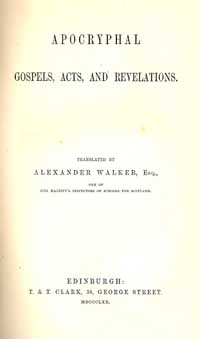 In actuality, there were gospels composed in the name ofevery apostle, including Thomas, Bartholomew and Phillip, but these texts are considered "spurious" and unauthorized. Although it would be logical for all those directly involved with Jesus to have recorded their own memoirs, is it not odd that there are so many bogus manuscripts? What does it all mean? If Peter didn't write the Gospel of Peter, then who did? And why? Is not the practice of pseudepigraphy—the false attribution of a work by one author to another—an admission that there were many people within Christianity engaging in forgery? If these apostles themselves had gospels forged in their names, how can we be certain that Matthew, Mark, Luke and John did not likewise have gospels falsified in theirnames?
In actuality, there were gospels composed in the name ofevery apostle, including Thomas, Bartholomew and Phillip, but these texts are considered "spurious" and unauthorized. Although it would be logical for all those directly involved with Jesus to have recorded their own memoirs, is it not odd that there are so many bogus manuscripts? What does it all mean? If Peter didn't write the Gospel of Peter, then who did? And why? Is not the practice of pseudepigraphy—the false attribution of a work by one author to another—an admission that there were many people within Christianity engaging in forgery? If these apostles themselves had gospels forged in their names, how can we be certain that Matthew, Mark, Luke and John did not likewise have gospels falsified in theirnames?According to Whom?
What we do know for a fact—admitted even by the Catholic Encyclopedia—is that the titles attached to the gospels, "The Gospel According to Matthew," etc., are not original to the texts but were added later. Indeed, the term "according to" in the original Greek—kata—could be interpreted to suggest that the texts were understood to be relating a tradition of these individuals, rather than having been written by them. In reality, none of the evangelists identifies himself as a character in the gospel story. As one glaring example of this detachment, it is claimed that Matthew was recording events he himself had witnessed, but the gospel attributed to him begins before he had been called by Jesus and speaks of Matthew in the third person….
This subject of attribution is extremely important, because, as Tenney asserts, "if it could be shown that any of the books of the New Testament was falsely attributed to the person whose name it bears, its place in the canon would be endangered."[4]
"Back in the Day…"
Furthermore, there are places in the New Testament that imply the books were written long after the purported events, such as when the text reads, "In the days of John the Baptist," which indicates that the writer is set far ahead in time and is looking back. As another example, regarding Jesus's body being stolen, Matthew's gospel claims that "this story has been spread among the Jews to this day." The phrase "to this day" indicates that the writer is talking about a significant length of time, not shortly after the resurrection as some have attempted to place the composition and emergence of this gospel. In fact, we do not have any mention in the historical record of the story of Christ's body being stolen having been spread among the Jews until the second century. It is possible that this particular verse was not added until that time, which means that it is not original to the gospel and that Matthew certainly is not its author. Also, Luke's gospel discusses an apparent myriad of preceding gospels written "by those who from the beginning were eyewitnesses…" The phrase "from the beginning" likewise implies a passage of time, as does the fact that there were "many" who preceded Luke in writing gospels.
Irenaeus, "Father of the Catholic Canon."
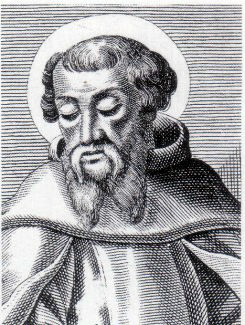 In addition to the issues already discussed in support of the later dates is the important fact that the four canonical gospels were not mentioned or named as such by anyone until the time of Church father Irenaeus, Bishop of Lyons (c. 120/140-c. 200/203ad/ce). In Against All Heresies (III, 11.8), written around 180 ad/ce, Irenaeus is the first to name the canonical gospels and give reasons for their inclusion and number in the New Testament…
In addition to the issues already discussed in support of the later dates is the important fact that the four canonical gospels were not mentioned or named as such by anyone until the time of Church father Irenaeus, Bishop of Lyons (c. 120/140-c. 200/203ad/ce). In Against All Heresies (III, 11.8), written around 180 ad/ce, Irenaeus is the first to name the canonical gospels and give reasons for their inclusion and number in the New Testament…
The remarks by Irenaeus represent the first mention of all four canonical gospels together. In fact, prior to the end of the second century, there is no clear evidence of the existence of the canonical gospels as we have them.
Church Father and Bishop Papias
Christian apologetics for the early gospel dates rely on the slimmest of evidence, including a very late third-hand testimony of a late second-hand testimony that "Mark" had written a narrative, supposedly based on the experiences of Peter as related by the apostle himself. In the fourth century, Church historian Eusebius quoted early Church father and bishop Papias of Hierapolis (c. 70?-c. 155? ad/ce) as referring to the "presbyter John"…
Regarding the bishop of Hierapolis, the Catholic Encyclopedia says, "Of Papias's life nothing is known."[5] In other words, we do not even know who this person is whom Eusebius is allegedly quoting regarding these purported earlier texts. According to Eusebius—in disagreement with Irenaeus, who suggested Papias had known the apostle John—Papias had no direct acquaintance with any of the apostles:
…Papias himself in the preface to his work makes it clear that he was never a hearer or eyewitness of the holy apostles, and tells us that he learnt the essentials of the faith from their former pupils.[6]
The assumption that the "presbyter John" with whom Papias apparently had a relationship was the same as the apostle John is evidently incorrect….
…Many of Papias's remarks, according to Eusebius, involved miracles, such as the raising of the dead, which stretch the credulity. Are we supposed merely to take Papias's word on what else he was told by these "former followers?" Moreover, even Eusebius does not think highly of Papias, remarking, "For he seems to have been a man of very small intelligence, to judge from his books."[7]
… Papias is one of the only pieces of evidence Christian apologetics offers as to the dating of the gospels—yet, his testimony concerning these writings of Mark and Matthew is not only second-hand but also too late to possess any value as concerns the earliest of the gospels dates. Moreover, Papias only speaks about a narrative by Mark, which by no means conclusively refers to the canonical Mark as we have it. Nor, as we have seen, is the Aramaic gospel of Matthew the same as the canonical Matthew….
Justin Martyr
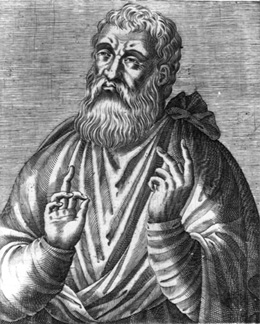 As proof of the existence of the gospels prior to the end of the second century, it is claimed that Church father Justin Martyr (c. 110-c. 165 ad/ce) included 268 "quotations of the New Testament" in his writings, an extraordinary figure from a chart in Josh McDowell's book New Evidence that Demands a Verdict.[8]However, the various assertions regarding "quotes" from biblical texts in early Christian writings rank as highly misleading. In the first place, there appears nothing prior to Justin Martyr (c. 150ad/ce) that we can point to as real evidence of the existence of the canonical gospels, which is why Justin Martyr heads the chart in McDowell's book. In fact, virtually all of the numerous quotes purportedly from the New Testament listed in the Catholic Encyclopedia,[9] for example, as found in earlier Christian writings constitute sayings that may have been transmitted orally or in other source texts such as the Aramaic Gospel of Matthew or Q. Next, upon close inspection, the material from Justin Martyr—such as the "Memoirs of the Apostles"—does not correspond well enough to that found in the canonical gospels and is likely from another common source text or texts. Indeed, renowned biblical scholar Tischendorf only managed to find twopertinent quotations in Justin Martyr's works that could possibly come from the gospel of Matthew, for example.[10] Again, these miniscule passages could very well come from a shared source text.
As proof of the existence of the gospels prior to the end of the second century, it is claimed that Church father Justin Martyr (c. 110-c. 165 ad/ce) included 268 "quotations of the New Testament" in his writings, an extraordinary figure from a chart in Josh McDowell's book New Evidence that Demands a Verdict.[8]However, the various assertions regarding "quotes" from biblical texts in early Christian writings rank as highly misleading. In the first place, there appears nothing prior to Justin Martyr (c. 150ad/ce) that we can point to as real evidence of the existence of the canonical gospels, which is why Justin Martyr heads the chart in McDowell's book. In fact, virtually all of the numerous quotes purportedly from the New Testament listed in the Catholic Encyclopedia,[9] for example, as found in earlier Christian writings constitute sayings that may have been transmitted orally or in other source texts such as the Aramaic Gospel of Matthew or Q. Next, upon close inspection, the material from Justin Martyr—such as the "Memoirs of the Apostles"—does not correspond well enough to that found in the canonical gospels and is likely from another common source text or texts. Indeed, renowned biblical scholar Tischendorf only managed to find twopertinent quotations in Justin Martyr's works that could possibly come from the gospel of Matthew, for example.[10] Again, these miniscule passages could very well come from a shared source text.
(For more on this subject of Justin Martyr’s value in establishing the existence of the canonical gospels, see my book Suns of God: Krishna, Buddha and Christ Unveiled.)
The Rylands Papyrus
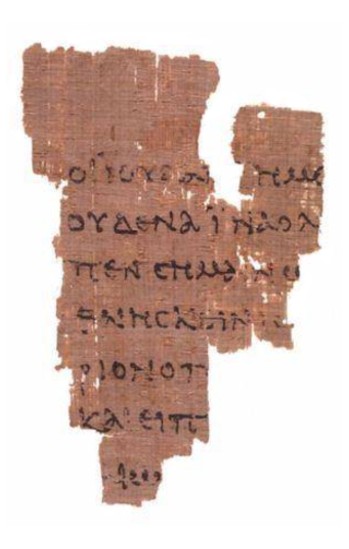 Aside from various sayings within the writings of the Church fathers that resemble those found in the gospels but may well come from common source texts, the only widely accepted evidence that places the emergence of any of the canonical gospels before the end of the second century is a small scrap of papyrus called the "Rylands fragment" or P52, which contains several dozen letters scattered across four verses of John's gospel (18:31-33). The dates for this tiny fragment—the provenance of which is unknown and the authenticity of which has been disputed—are by no means set in stone and have been posited from the "wishful thinking" of 90 ad/ce all the way to the end of the second century. The presumed dating of P52 to the first half of the second century has been called "sensational" and seems untenable. One significant argument against the early dating of P52 is that the fragment was part of a codex, or book, rather than a scroll, and there are few examples of such books in existence at such an early date. Moreover, in a fairly recent paleographical study published in the Archiv für Papyrusforschung 35 (1989), German scholar Andreas Schmidt suggested a date for P52 of 170 ad/ce +/- 25 years….
Aside from various sayings within the writings of the Church fathers that resemble those found in the gospels but may well come from common source texts, the only widely accepted evidence that places the emergence of any of the canonical gospels before the end of the second century is a small scrap of papyrus called the "Rylands fragment" or P52, which contains several dozen letters scattered across four verses of John's gospel (18:31-33). The dates for this tiny fragment—the provenance of which is unknown and the authenticity of which has been disputed—are by no means set in stone and have been posited from the "wishful thinking" of 90 ad/ce all the way to the end of the second century. The presumed dating of P52 to the first half of the second century has been called "sensational" and seems untenable. One significant argument against the early dating of P52 is that the fragment was part of a codex, or book, rather than a scroll, and there are few examples of such books in existence at such an early date. Moreover, in a fairly recent paleographical study published in the Archiv für Papyrusforschung 35 (1989), German scholar Andreas Schmidt suggested a date for P52 of 170 ad/ce +/- 25 years….
The same may be said of the other early papyri fragments, P90 (Jn 18:36-40; 19:1-7), P98 (Rev 1:13-20) and P104 (Mt 21:34-37; 43, 45?), speculatively dated to the middle of the second century +/- 50 years….
Late Dating of the Gospels?
It is not within the scope of this present work to examine thoroughly the alternative argument for a late dating of the gospels. This important scholarship is based principally on a close examination of the most ancient Christian texts,[11] as well as archaeological evidence—or lack thereof—and various anachronisms. The result is that there is good reason to include these late dates in our investigation, and doing so may yield some surprising results concerning the authorship of the gospels.
To demonstrate how alternative dating of at least one of the gospels may provide solutions to outstanding problems, we will take as an example the gospel of Luke, particularly since it is asserted that "the key to dating the Gospels is the Book of Luke."[12]
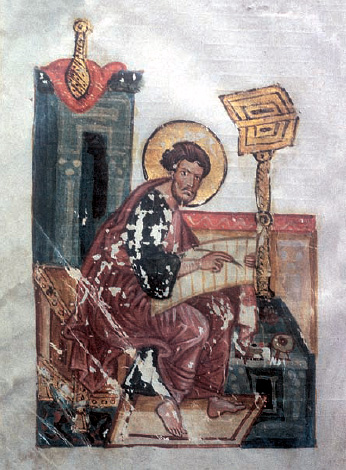 In dating Luke's gospel, which is addressed to "most excellent Theophilus," it should first be noted that nowhere does the author identify himself as the Luke who was a companion of Paul, mentioned in three Pauline epistles. In fact, other than the title "the Gospel according to Luke"—which is admitted by all authorities to be an addition and not original to the text—Luke's name does not show up inany gospel. Despite outward appearances, it is by no means certain that the author of Luke, who was neither an apostle nor a known disciple, was anywhere near in time to the events he is recording. When we factor in the Acts of the Apostles, which is widely regarded as having been written by the same person as the gospel of Luke and which likewise addresses "Theophilus," a whole new can of worms is opened, as there is also no record of that book having been written or existing before the end of the second century. Furthermore, other than the Jewish high priest Theophilus (37-41 ad/ce) briefly mentioned in Josephus (Ant., XVIII, 5, 3)—a highly unlikely candidate for Luke's pen-pal, particularly since Josephus certainly says nothing about what would constitute a stunning conversion to Christianity—there is no appearance in the historical record of any other "Theophilus" earlier than the bishop of Antioch (fl. c. 168-c. 181/188 ad/ce). Thus, the identity of Luke's Theophilus has never been explained adequately in terms of the purported era of Christ's advent.
In dating Luke's gospel, which is addressed to "most excellent Theophilus," it should first be noted that nowhere does the author identify himself as the Luke who was a companion of Paul, mentioned in three Pauline epistles. In fact, other than the title "the Gospel according to Luke"—which is admitted by all authorities to be an addition and not original to the text—Luke's name does not show up inany gospel. Despite outward appearances, it is by no means certain that the author of Luke, who was neither an apostle nor a known disciple, was anywhere near in time to the events he is recording. When we factor in the Acts of the Apostles, which is widely regarded as having been written by the same person as the gospel of Luke and which likewise addresses "Theophilus," a whole new can of worms is opened, as there is also no record of that book having been written or existing before the end of the second century. Furthermore, other than the Jewish high priest Theophilus (37-41 ad/ce) briefly mentioned in Josephus (Ant., XVIII, 5, 3)—a highly unlikely candidate for Luke's pen-pal, particularly since Josephus certainly says nothing about what would constitute a stunning conversion to Christianity—there is no appearance in the historical record of any other "Theophilus" earlier than the bishop of Antioch (fl. c. 168-c. 181/188 ad/ce). Thus, the identity of Luke's Theophilus has never been explained adequately in terms of the purported era of Christ's advent.
Some scholars and apologists have sought to explain this name "Theophilus" as more of an epithet, meaning "Lover of God"; hence, it has been suggested that Luke was addressing his text to "God-lovers" in general. Among other reasons, the fact that Acts also begins with a greeting to this "Theophilus" makes it more likely that it is a name of an individual, not simply a title. In the original Greek, Luke calls Theophilus "kratistos," a term used biblically with the following meaning, per Strong's Biblical Concordance (G2903):
1) mightiest, strongest, noblest, most illustrious, best, most excellent
a) used in addressing men of prominent rank or office
In discussing the word "Theophilus," Strong's asserts that it is a single individual to whom Luke is addressing his gospel and Acts. In addition, someone with the title kratistos is likely not to be an obscure, lower-class individual but, rather, a person of rank.
Theophilus, Bishop of Antioch
Concerning Theophilus, Christian biblical commentator David Brown remarks, "It is likely 'Theophilus' was chief magistrate of some city in Greece or Asia Minor." Could not this "chief magistrate" be a bishop, and this "city in Asia Minor" be Antioch? Especially since it was asserted by ancient authorities that Luke himself was from Antioch? And that the Christians were first so-called at Antioch?...
In any event, with the reference in his apology and a purported text of commentaries on the gospels, Bishop Theophilus becomes the first Church father clearly to discuss the canonical gospels!...
Why, then, is this important Christian authority rarely discussed? Is it because, perhaps, Theophilus represents a "smoking gun" when it comes to unraveling the era of the canonical gospels' composition?...
Who are the "Many?"
The fact that Luke is superseding "many" narratives also fits in with the idea that his gospel was composed at the end of the second century, as there were many gospels by that time.[13] Trying to fit Luke into the middle or end of the first century, however, is an endeavor rife with problems, including that there certainly were not "many" gospels in circulation or even in existence by that time. This suggestion also presents us with some clarity on the tradition beginning in the late second century that Luke's gospel supposedly had been 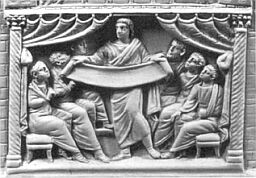 corrupted by Marcion during the middle of the second century. In reality, it seems the author of Luke may have based his gospel on Marcion's "Gospel of the Lord," rather than vice versa. Furthermore, in determining which texts Luke may be referring to, a number of Church fathers, including Origen, Epiphanius and Jerome, as well as other Christian authorities such as the Venerable Bede (8th cent.), evidently named books from authors of thesecond century such as the Gospels of the Egyptians and the Twelve Apostles, as well as the writings of the Gnostic-Christian heretic Cerinthus.[14]
corrupted by Marcion during the middle of the second century. In reality, it seems the author of Luke may have based his gospel on Marcion's "Gospel of the Lord," rather than vice versa. Furthermore, in determining which texts Luke may be referring to, a number of Church fathers, including Origen, Epiphanius and Jerome, as well as other Christian authorities such as the Venerable Bede (8th cent.), evidently named books from authors of thesecond century such as the Gospels of the Egyptians and the Twelve Apostles, as well as the writings of the Gnostic-Christian heretic Cerinthus.[14]
 corrupted by Marcion during the middle of the second century. In reality, it seems the author of Luke may have based his gospel on Marcion's "Gospel of the Lord," rather than vice versa. Furthermore, in determining which texts Luke may be referring to, a number of Church fathers, including Origen, Epiphanius and Jerome, as well as other Christian authorities such as the Venerable Bede (8th cent.), evidently named books from authors of thesecond century such as the Gospels of the Egyptians and the Twelve Apostles, as well as the writings of the Gnostic-Christian heretic Cerinthus.[14]
corrupted by Marcion during the middle of the second century. In reality, it seems the author of Luke may have based his gospel on Marcion's "Gospel of the Lord," rather than vice versa. Furthermore, in determining which texts Luke may be referring to, a number of Church fathers, including Origen, Epiphanius and Jerome, as well as other Christian authorities such as the Venerable Bede (8th cent.), evidently named books from authors of thesecond century such as the Gospels of the Egyptians and the Twelve Apostles, as well as the writings of the Gnostic-Christian heretic Cerinthus.[14]
In reality, the earliest mentions of the Gospel of the Egyptians appear to be in the writings of Church fathers at the end of the second century to the fourth century, such as Clement Alexandrinus, Origen, Hippolytus and Epiphanius. But, even the earliest of the dates for this gospel and that of the Twelve Apostles would place the composition of Luke at the end of the first century at the very earliest. Moreover, Basilides supposedly thrived during Hadrian's reign, which ended in 138 ad/ce. Any work of Basilides would date to no earlier than the first quarter of the second century.
From translations of the original Latin, it appears that Jerome, for example, is stating that the texts of the "many" to whom Luke refers include the gospels of the Egyptians and the Twelve Apostles, as well as those of Thomas, Matthias, Bartholomew, Basilides and Appelles. With this evident validation, Jerome dropped a bombshell which might have shaken the foundations of the Church but which has apparently been ignored, with translations omitting this part of the saint's Preface, and the original Latin of which possibly difficult to track down outside of a major university. Whether or not Luke used these particular texts is immaterial, as what is important is that, in referring to these writers at all, Luke must have composed his gospel after these heretical books already existed. Like those of the Egyptians and Twelve Apostles, none of the gospels of Thomas, Matthias and Bartholomew can be placed earlier than the second century, although there are "wishful-thinking" first-century arguments for Thomas, evidently the earliest of the three….
Luke's Use of Josephus?
Another longstanding argument for a later date for Luke's gospel is that the evangelist used the works of Jewish historian Josephus to pad out his history. Although Christian apologetics argues for the opposite influence, when the most scientific criteria are applied to the investigation, Josephus comes up first, with Luke following. These arguments are lengthy but include Luke's inclusion of the following episodes found in Josephus:
- The census under Quirinius/Cyrenius
- The three Jewish rebel leaders
- The death of Herod Agrippa
- Various aspects of Felix's life
- The tetrarch Lysanias
- The "parable of the hated king"
- The famine during the reign of Claudius
- Pilate's aggressions[15]…
In this scenario of Luke using Josephus, the earliest time for the composition of Luke's gospel would be the last decade of the first century. However, as we have seen, there is reason to suspect that it was composed much later, nevertheless using possibly the best known history of that era, the works of Josephus.
There are thus several good and valid reasons to suspect that, despite current beliefs regarding its date, the gospel of Luke as we have it represents a late second-century creation.
John's Gospel
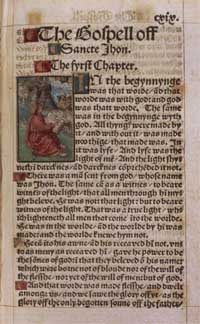 The first notice of John's gospel emerges around the time of Bishop Theophilus, who, while he does name a "John" as the author of verses seemingly from the first chapter of the gospel of John, does not identify the author as a direct apostle or disciple of Christ.
The first notice of John's gospel emerges around the time of Bishop Theophilus, who, while he does name a "John" as the author of verses seemingly from the first chapter of the gospel of John, does not identify the author as a direct apostle or disciple of Christ.
Other mentions of John's gospel occur around the same time by Clement Alexandrinus (d. c. 215), as well as commentary by Tatian (fl. 160-185), and then a grandiose and strident apology by Irenaeus, from whose pen it has been suspected the gospel originally emanated, as a defense against the "heretical" but powerful Gnostic sect of Docetism…. The argument for this assertion that Irenaeus himself authored John includes the fact that the Church father was provoked passionately to defend the gospel, which he does with a fervor that often accompanies a "pet project." Even if John were composed by another's hand, this abundance of defense suggests that the gospel had not been in existence for a long time, as has been claimed, but had only recently emerged in the literary and historical record, leading to the gospel immediately being attacked and dismissed….
Gospel Anachronisms
In addition to these profound reasons for a later dating of the canonical gospels as we have them, some of the variant readings and assorted other anachronisms within the gospels tend to confirm these late dates in terms of words used, writing style, and politics of the day as well. As examples of terms anachronistically used that indicate a late dating for at least parts of the gospels, a number of word usages supposedly articulated by Jesus were not "in vogue" until after the destruction of the Jewish temple in 70 ad/ce. These terms used anachronistically in the gospels include: 1. "Gehenna" (Hell) as a place of punishment; 2. "synagogue" as concerns a place of prayer; 3. "sanhedrin" as referring to the Jewish court; and 4. "mammon" as meaning "money."[16] In the Sermon on the Mount in Matthew, Jesus is represented as assailing prayer in public, as in the synagogues, when in reality synagogues were never used as houses of prayer until after the temple was destroyed. Hence, this part of the Sermon could not have been written until after that time… As Jewish scholar Gerald Friedlander states in The Jewish Sources of the Sermon on the Mount, "Four-fifths of the Sermon on the Mount is exclusively Jewish."[17]
Another similar anachronism in the gospels appears in the description of the "disciples of the Pharisees," as at Mark 2:18 and Luke 5:33. Since the Pharisees were technically not "priests" per se but pious, unlearned laymen, it would be unusual for them to have "disciples" in the clerical sense.
This phrase may not have come into use until after the destruction of the temple in 70ad/ce, which would mean that the writers were distanced from the events by a considerable amount of time.[18]
The Canon: A Second-Century Composition
With such remarkable declarations of the Church fathers, et al., as well as other cogent arguments, we possess some salient evidence that the gospels of Luke and John represent late second-century works. In fact, all of the canonical gospels seem to emerge at the same time—first receiving their names and number by Irenaeus around 180 ad/ce, and possibly based on one or more of the same texts as Luke, especially an "Ur-Markus" that may have been related to Marcion's Gospel of the Lord. In addition to an "Ur-Markus" upon which the canonical gospels may have been based has also been posited an "Ur-Lukas," which may likewise have "Ur-Markus" at its basis.
The following may summarize the order of the gospels as they appear in the historical and literary record, beginning in the middle of the second century:
- Ur-Markus (150)
- Ur-Lukas (150+)
- Luke (170)
- Mark (175)
- John (178)
- Matthew (180)
To reiterate, these late dates represent the time when these specific texts undoubtedly emerge onto the scene.[19] If the canonical gospels as we have them existed anywhere previously, they were unknown, which makes it likely that they were not composed until that time or shortly before, based on  earlier texts. Moreover, these dates correspond perfectly with Theophilus's bishopric of Antioch, which has been dated from about 168 to either 181 or 188 and during which the first definite indications of the canonical gospels begin to materialize. After this time, in fact, the floodgates open up, with Irenaeus's canon, followed by gospel commentaries of all manner by Irenaeus, Tertullian (c. 160-?; fl. 197), Origen, Eusebius, Chrysostom, Jerome and Augustine, et al. At least three Church fathers, as we have seen, pointed to Gnostic heretics of the second century as some of the "many" in Luke's prologue, also verifying a late second-century date for the emergence of that gospel.
earlier texts. Moreover, these dates correspond perfectly with Theophilus's bishopric of Antioch, which has been dated from about 168 to either 181 or 188 and during which the first definite indications of the canonical gospels begin to materialize. After this time, in fact, the floodgates open up, with Irenaeus's canon, followed by gospel commentaries of all manner by Irenaeus, Tertullian (c. 160-?; fl. 197), Origen, Eusebius, Chrysostom, Jerome and Augustine, et al. At least three Church fathers, as we have seen, pointed to Gnostic heretics of the second century as some of the "many" in Luke's prologue, also verifying a late second-century date for the emergence of that gospel.
 earlier texts. Moreover, these dates correspond perfectly with Theophilus's bishopric of Antioch, which has been dated from about 168 to either 181 or 188 and during which the first definite indications of the canonical gospels begin to materialize. After this time, in fact, the floodgates open up, with Irenaeus's canon, followed by gospel commentaries of all manner by Irenaeus, Tertullian (c. 160-?; fl. 197), Origen, Eusebius, Chrysostom, Jerome and Augustine, et al. At least three Church fathers, as we have seen, pointed to Gnostic heretics of the second century as some of the "many" in Luke's prologue, also verifying a late second-century date for the emergence of that gospel.
earlier texts. Moreover, these dates correspond perfectly with Theophilus's bishopric of Antioch, which has been dated from about 168 to either 181 or 188 and during which the first definite indications of the canonical gospels begin to materialize. After this time, in fact, the floodgates open up, with Irenaeus's canon, followed by gospel commentaries of all manner by Irenaeus, Tertullian (c. 160-?; fl. 197), Origen, Eusebius, Chrysostom, Jerome and Augustine, et al. At least three Church fathers, as we have seen, pointed to Gnostic heretics of the second century as some of the "many" in Luke's prologue, also verifying a late second-century date for the emergence of that gospel.
When one considers the amount of time, effort and resources put into New Testament studies and criticism over the centuries, it is understandable that the wagons would circle whenever someone comes along with suggestions seemingly out of the ordinary, such as asserting late dates for the canonical gospels. One must ask, however, if there is no clear scientific evidence for the existence of these gospels before that time, would it not be more honest to entertain at least the possibility of their having been composed at a later date? One reason why considering this possibility is so important is precisely because there have been so much time, effort and resources put into NT studies. Some of the hardest nuts to crack exist largely because of the early dates attached to these texts, without valid scientific evidence. Without proper dates for these gospels, we will have little luck in establishing who Jesus was.
[1] See "The 'Historical' Jesus?" chapter in my book Suns of God for more discussion of the scholarship over the centuries regarding the dating and order of the canonical gospels.
[2] Geisler, CA, 327.
[3] Strobel, 26.
[4] Tenney, 402.
[5] CE, "St. Papias."
[6] Eusebius (III, 39:2), 101-102.
[7] Eusebius (III, 39), 103.
[8] McDowell, 43.
[9] CE, "Gospel of St. Matthew."
[10] See also Suns of God for a thorough discussion about the value of Justin Martyr as well as other Christian and non-Christian evidences.
[11] The minutiae of this subject can be studied in Walter Richard Cassels's exhaustive analysis Supernatural Religion, an comprehensive survey of all of the early Christian writings in the original Greek and Latin, with English translations and commentary.
[12] Geisler, CA, 312.
[13] Waite notes that the German critic Schleiermacher determined Luke's gospel to have been compiled from 33 different manuscripts, and he shows the very divisions upon which these are delineated (Waite, 379-380). According to Waite's survey of Church fathers and other Christian authorities, "It is the universal conclusion, that the author of Luke does not here refer to any of the canonical gospels." (385)
[14] Waite, 385-6.
[15] Carrier, "Luke and Josephus."
[16] Friedlander, xii, xviii, xxx-xxxi.
[17] Friedlander, 266.
[18] Meier, II, 442-443.
[19] See Waite for arguments supporting this dating and order.
Bibliography
Acharya S. Suns of God: Krishna, Buddha and Christ Unveiled. Illinois: AUP, 2004.
Carrier, Richard, "Luke and Josephus," www.infidels.org/library/modern/richard_carrier/lukeandjosephus.html
Cassels, Walter. Supernatural Religion: An Inquiry into the Reality of Divine Revelation. New York: D.M. Bennett, 1879.
Catholic Encyclopedia. "Gospel of St. Matthew," www.newadvent.org/cathen/10057a.htm
—"St. Papias," www.newadvent.org/cathen/11457c.htm
Eusebius. The History of the Church. New York: Penguin, 1989.
Friedlander, Gerald. The Jewish Sources of the Sermon on the Mount. New York: KTAV Publishing, 1969.
Geisler, Norman L. Christian Apologetics. Secunderabad: OM Books, 1999.
McDowell, Josh. New Evidence that Demands a Verdict. Nashville: Thomas Nelson Publishers, 1999.
Meier, John P. A Marginal Jew: Rethinking the Historical Jesus, v. I & II. New York: Doubleday, 1991/1994.
Strobel, Lee. The Case for Christ. Zondervan, 1998.
Tenney, Merrill C. New Testament Survey, Michigan: Wm. B. Eerdmans Publishing Company, 1985.
Waite, Charles. History of the Christian Religion to the Year Two Hundred Oregon: Dr. Carroll Bierbower, 1992.


Δεν υπάρχουν σχόλια:
Δημοσίευση σχολίου